Abstract
Mold electromagnetic stirring (M-EMS) has been widely used in many continuous casters. In order to have a deep insight into the collision-coalescence among inclusions under M-EMS by a Eulerian approach, the effects of Archimedes electromagnetic force on the inclusion are expressed by three-dimensional Archimedes electromagnetic slipping velocity and Archimedes electromagnetic collision. Numerical results show that a turbulent collision is the most important factor to cause inclusions to collide with each other, Archimedes electromagnetic collision has a minor effect, Stokes collision is the third factor, and Brownian can be ignored. In the case of M-EMS, there are two recirculation zones above and below the M-EMS central cross-section, and the inclusion spatial distributions have the inverted U-shape.
1. Introduction
As a vital process in steel production, curved continuous casting is applied in many steel companies because of low-energy consumption, high efficiency and metallic yield [1,2]. During the curved continuous casting process, the liquid steel flows through the ladle and the tundish to the mold, as shown in Figure 1, and the continuous casting billet is formed and cooled gradually after the solidification in the mold. In recent years, the quality requirements of steel products have become increasingly strict for an excellent drawing property, low-temperature toughness and fatigue resistance. Thus, the inclusion content in liquid steel, which has a negative effect on the steel properties, must be reduced to a fairly low level to satisfy the production requirement [3,4,5]. In order to improve the billet quality effectively, mold electromagnetic stirring (M-EMS) has been used to change the fluid flow and promote the inclusion removal in liquid steel in many steel companies [6,7,8,9].
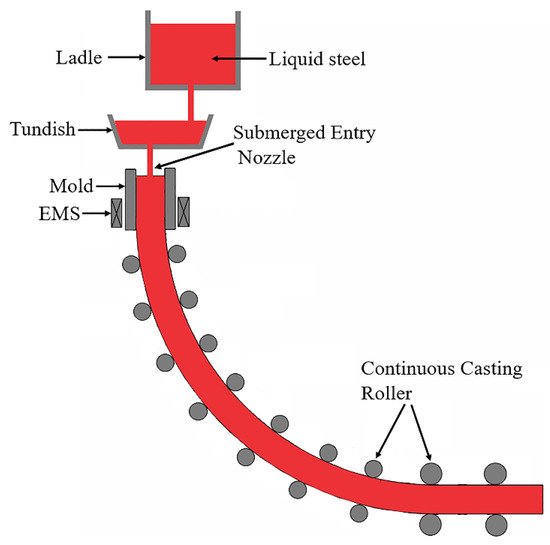
Figure 1.
Schematic of curved continuous casting process.
Numerical simulation is a popular method because it can provide the detailed information about metallurgical process, and it is not limited by the high temperature condition and costly expense. Currently, the homogeneous model and non-homogeneous model are two popular mathematical models in numerical simulation to describe the inclusion behavior, and the non-homogeneous models can be classified as the Eulerian approach and the Lagrangian approach [10,11,12,13,14,15].
However, some important problems about the inclusion behavior in a continuous casting process are far from being solved. In the electromagnetic field, the inclusion movement is affected the electromagnetic force (Archimedes electromagnetic force [4]), which has the similar characteristics to the buoyancy (Archimedes force) of inclusion particle in molten steel. The difference between Archimedes force and gravity of inclusion causes Stokes collision. Such a rule also applies to Archimedes electromagnetic force. Consequently, the collision among inclusions caused by Archimedes electromagnetic force is called as Archimedes electromagnetic collision. There are numerous papers about inclusion trajectories in the metallurgical reactor with electromagnetic stirring (EMS), but few papers refer to inclusion spatial distribution in the curved continuous caster under the electromagnetic field [16,17]. Thus, it is necessary to have a deep insight into the effect of Archimedes electromagnetic force on the inclusion behavior in the curved bloom continuous caster with M-EMS.
2. Mathematical Model
In the curved bloom continuous caster, the liquid bearing steel flow is calculated by the standard turbulence model. Figure 2 gives the calculation procedure of the mathematical model. Firstly, Maxwell’s equations are solved to obtain the spatial distribution of electromagnetic force in the curved bloom continuous caster. Secondly, the momentum conservation equations considering the electromagnetic force and the mass conservation equation are solved to obtain the velocity field of liquid steel. Finally, in order to get the inclusion spatial distribution (the number density, the characteristic radius and the volumetric concentration) in the continuous caster with M-EMS, the three-dimensional Archimedes electromagnetic slip velocity and Archimedes electromagnetic collision are introduced in the inclusion population conservation equation and the inclusion mass conservation equation.
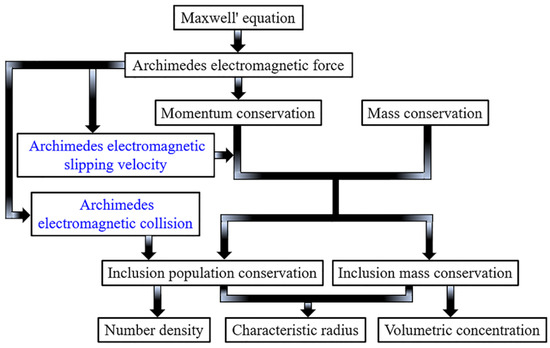
Figure 2.
Calculation procedure of the mathematical model.
2.1. Electromagnetic Field
The magnetic field caused by the M-EMS is quasi-static magnetic field because the alternating current in the M-EMS is 2.5 Hz, and the magnetic Reynolds number for the current case is less than 0.04. Consequently, the related governing equations for the electromagnetic field of M-EMS are summarized in Table 1.

Table 1.
Governing equations of electromagnetic field.
2.2. Fluid Flow
The liquid bearing steel is incompressible Newtonian fluid and the fluid flow is considered to be the isothermal steady turbulent flow. The density of bearing steel at the liquid state is equal to that at solid state because the density difference of bearing steel is about 2% when the temperature changes from 298 K to 1768 K. Thus, the continuity equation and the momentum equation can be expressed as [18,19]:
where p is the pressure, Pa; is the gravitational acceleration, m/s2; is the effective viscosity coefficient, Pa·s, which is determined by standard turbulence model; is the fluid velocity, m/s; is the fluid density, kg/m3.
2.3. Inclusion Collision-Coalescence
Because the inclusion behavior in liquid steel is very complex, some reasonable assumptions are applied to simplify the inclusion transport model.
- (1)
- The inclusion can be treated as the continuous phase.
- (2)
- Inclusions are spherical particles.
- (3)
- In order to simplify the inclusion collision-aggregation model, the fractional inclusion number density increases exponentially as the inclusion size decreases, , and A and B only depend on time and coordinates [3,11,12,13].
- (4)
- Each inclusion moves independently until the collision among inclusions occurs.
- (5)
- Brownian collision among the inclusions is so weak that it can be neglected [12].
- (6)
- There is no chemical reaction occurring in the molten steel.
- (7)
- The effect of the inclusion on the macroscopic flow of liquid steel can be ignored because of the low volume fraction of the inclusion.
- (8)
- The inclusion is removed from the liquid steel once it touches the top slag, the mold wall or the solidifying shell.
Based on the steady flow of liquid steel, the collision-coalescence among inclusions in the bloom continuous caster can be described by the inclusion population conservation equation and the inclusion mass conservation equation [11,12,20].
where N and C are the inclusion number density and the inclusion volume concentration, respectively. The source term in the Equation (3) depends on the collision-coalescence among inclusions. And the effective diffusion coefficient can be expressed as:
where is the molecular diffusion coefficient, m2/s; is the turbulent viscosity, Pa·s; is the turbulent Schmidt number.
On the base of the mass conservation, the inclusion characteristic radius (or volume average radius) is the function of inclusion volume concentration (C) and the inclusion number density (N).
The inclusion convection velocities and in Equations (3) and (4) are the sum of the liquid steel velocity () and the inclusion slipping velocity ().
The forces acting on the inclusion particle include the gravity, the buoyancy, the viscous drag force and Archimedes electromagnetic force. The buoyancy of a particle with the same size depends on the function of the density difference between steel and inclusion, it is a constant. However, the Archimedes electromagnetic force is the function of electromagnetic force. It will change with the local electromagnetic condition. Thus, the terminal velocity of inclusion can be obtained under the condition of force balance of the inclusion particle:
Usually, the particle slipping velocity is in the direction of gravity. But the particle slipping velocity in the electromagnetic field is three-dimensional because the current density and the magnetic flux density are three-dimensional. The two terms to the right side of Equation (9) have clear physical meaning. The first term comes from the difference between the buoyancy and the gravity, the second term comes from Archimedes electromagnetic force.
The inclusion slipping velocity in Equations (7) and (8) is the function of Archimedes electromagnetic force and density difference between molten steel and inclusion, as shown in Equation (9). Thus the inclusion slipping velocity also include two parts: Stokes floating velocity and Archimedes electromagnetic slipping velocity. In this way, on the base of in assumption (3), the inclusion slipping velocity can be expressed as follows:
For the inclusion in liquid steel in the electromagnetic field, there are four inclusion collision mechanisms: Brownian collision, Archimedes electromagnetic collision, Stokes collision and the turbulent collision. Archimedes electromagnetic collision is similar to Stokes collision. The differences between them are as follows. Stokes collision comes from the buoyancy, the gravity and the drag force, and such a collision occurs in the direction of gravity direction. But Archimedes electromagnetic collision comes from Archimedes electromagnetic force and the drag force, and such a collision occurs in any direction.
Their related collision rates can be expressed as follows,
Brownian collision [21]:
Stokes collision:
Archimedes electromagnetic collision:
Turbulent collision [22]:
Because Brownian collision is at least two orders smaller than turbulent collision if the inclusion size is greater than 1 micro, it can be ignored in the current collision-coalescence mathematical model [12]. Thus, the source term in the inclusion population conservation equation can be expressed as:
where , and represent the contributions from Stokes collision, Archimedes electromagnetic collision and the turbulent collision, respectively.
where is the coagulation coefficient [12].
2.4. Computational Conditions and Procedure
Figure 3 shows the schematic diagram of M-EMS, and the computational domain is covered by about 350,000 structured grids. Table 2 gives geometric and physical parameters during the calculation, which are obtained from the industrial experiments on bearing steel in a steel company. The inclusions are pure solid Al2O3.
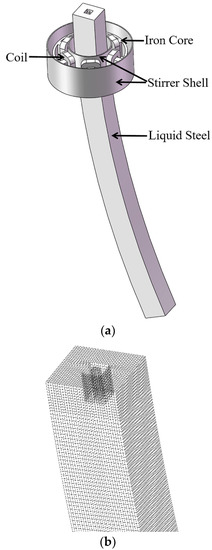
Figure 3.
Schematic diagram and local grids of mold electromagnetic stirring (M-EMS) with curved continuous casting bloom: (a) schematic diagram; (b) local grids.

Table 2.
Geometric and physical parameters.
For the electromagnetic field, the software ANSYS is employed to obtain the electromagnetic force. Alternating current (AC) at low frequency is applied to the coil and the phase difference among three-phase currents is 120°. The magnetic flux-parallel condition is imposed at the boundary of the computational domain.
On the basis of the finite volume method, the partial differential equations for the fluid flow and the inclusion collision-coalescence are solved by the computational fluid dynamics software CFX, and the convergence criteria is that the root-mean-square normalized residual for all variables is less than 10−6. For the flow field, the velocity inlet condition is imposed at the nozzle inlet according to the bloom casting speed. The free slip wall condition, no slip wall condition and the average static pressure condition are applied to the free surface, the walls and the outlet of the bloom, respectively.
For the inclusion in liquid steel, there are two transport mechanisms: the convection and the diffusion. The inclusion flux at the walls includes the convection flux (, ) and the diffusion flux (, ):
where is the normal vector, and the coefficient of can be expressed as [23]:
where is the turbulent wall friction, Pa, and is the empirical constant in the standard turbulent model.
The inclusion flux at the free surface also includes the convection flux and the diffusion flux:
Thus, the inclusion transport boundary conditions are summarized in Table 3.

Table 3.
Boundary conditions for inclusion transport.
3. Results and Discussion
3.1. Model Validation
Figure 4 shows that the predicted magnetic flux density agrees well with the experimental data. The magnetic field is measured by the digital Gaussmeter CH-1800 in the actual curved continuous caster. The maximum magnetic flux density along the central axis of bloom is 52 mT when the current is 500 A and the frequency is 2.5 Hz.
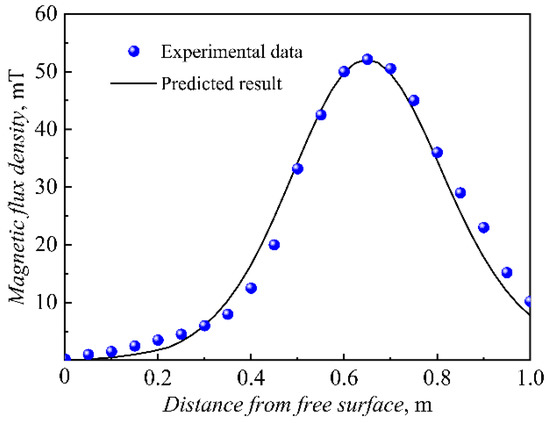
Figure 4.
Magnetic flux density along the axis of bloom with M-EMS.
In a curved bloom continuous caster, the mechanisms of fluid flow and inclusion behavior are similar with that in tundish. In order to confirm the validity of the numerical results, fluid flow and inclusion number density were validated with the experimental data of the tundish [20,24]. These results will not be discussed in detail.
3.2. Electromagnetic Force
Figure 5 gives the predicted distribution of electromagnetic force on the EMS central cross-section when the current is 500 A and the frequency is 2.5 Hz. The electromagnetic force, which is centrosymmetric in the cross-section, rotates around the axis of the bloom, and the force is minimal near the axis. It also shows that the maximum force appears near the bloom shell, which is about 5000 N/m3.
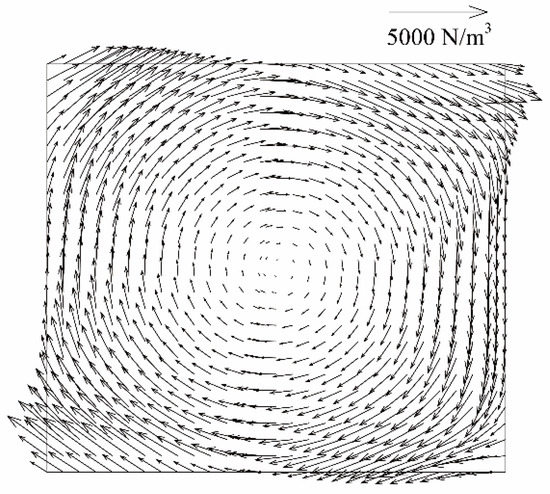
Figure 5.
Electromagnetic force distribution at EMS central cross-section in curved bloom continuous caster.
3.3. Fluid Flow
Figure 6 and Figure 7 show the predicted liquid steel flow in the curved bloom continuous caster without/with M-EMS. The flow fields have the following features. (1) A strong jet flow comes from the nozzle to the mold, and then spreads outward gradually with the fluid flow. (2) The velocity of liquid steel near the nozzle is greater than that in other part of the continuous caster, and the maximum velocity appears near the central axis of the mold. (3) In the M-EMS central cross-section, the fluid velocity near the mold wall is greater than that near the center. (4) There are two recirculation zones on both side of the nozzle.
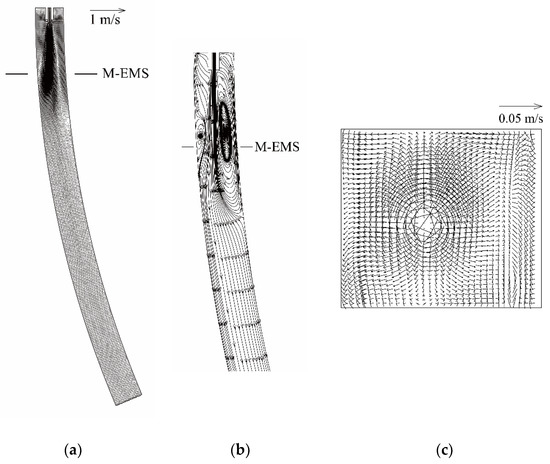
Figure 6.
Liquid steel flow in curved bloom continuous caster without M-EMS: (a) vertical longitudinal-section; (b) stream line (enlarged part); (c) M-EMS central cross-section.
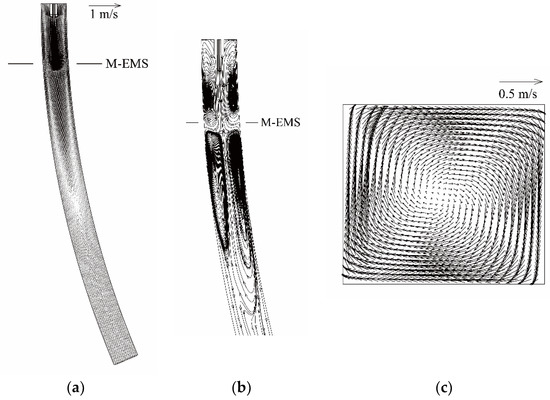
Figure 7.
Liquid steel flow in curved bloom continuous caster with M-EMS: (a) vertical longitudinal-section; (b) stream line (enlarged part); (c) M-EMS central cross-section.
Figure 6 and Figure 7 also give the differences between these flow fields. (1) In the case of no M-EMS, only a small part of the liquid steel returns to the free surface on the inner arc side. (2) In the case of M-EMS, the flow field is close to the symmetrical pattern on the vertical longitudinal-section. (3) The fluid velocity at the free surface in the case of M-EMS is greater than that in the case of no M-EMS. (4) In the case of M-EMS, there are four recirculation zones. Two recirculation zones are above the M-EMS central cross-section, and the other two recirculation zones are below the M-EMS central cross-section. (5) Because of the strong electromagnetic force, the fluid velocity on the M-EMS central cross-section with M-EMS is one order greater than that without M-EMS. (6) In the case of M-EMS, the direction of swirling flow is the same as the direction of rotating electromagnetic force, and the magnitude of the fluid velocity in the case of M-EMS is one order greater than that in the case of no M-EMS.
3.4. Inclusion Collision Mechanism
Usually, there are three inclusion collision mechanisms among particles: turbulent collision, Stokes collision and Brownian collision. In the case of an electromagnetic field, there is a fourth collision mechanism: Archimedes electromagnetic collision. The effect of Archimedes electromagnetic force on the inclusion behavior consists of Archimedes electromagnetic slipping velocity and Archimedes electromagnetic collision. Figure 8 gives the contribution of different collision mechanism to the inclusion collision. Turbulent collision is the most important mechanism of collision among inclusions. It is about two orders greater than Archimedes electromagnetic collision and Stokes collision if the inclusion size is less than 10 μm, and it is about one order greater than Archimedes electromagnetic collision and Stokes collision if the inclusion size is greater than 10 μm. With inclusion diameter increases, the difference between turbulent collision rate and Archimedes electromagnetic collision decreases gradually. Brownian collision is the most weakest collision, and the related collision is only about . It should be noted that the Archimedes electromagnetic collision rate and Stokes collision rate is zero if two inclusions have the same size.
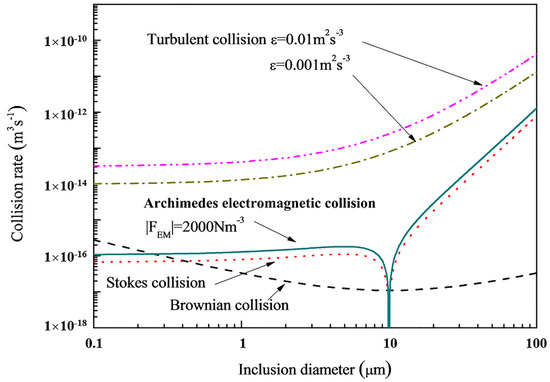
Figure 8.
Different collision rates in the case of M-EMS.
3.5. Inclusion Spatial Distribution
Figure 9 and Figure 10 show that the inclusion spatial distributions in the curved bloom continuous caster without/with M-EMS have the following similar features: (1) because the inclusions are absorbed by the solidified shell, the inclusion volume concentration and the inclusion number density decreases gradually as the distance from the free surface increases; (2) because the collision-coalescence among inclusions occurs and the inclusion terminal floating velocity is less than the casting speed, the characteristic radius increases gradually as the distance from the free surface increases.
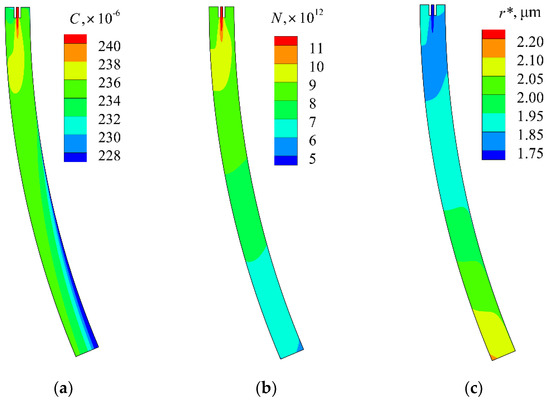
Figure 9.
Inclusion distribution at vertical longitudinal-section in curved bloom continuous caster without M-EMS: (a) volume concentration; (b) number density; (c) characteristic radius.
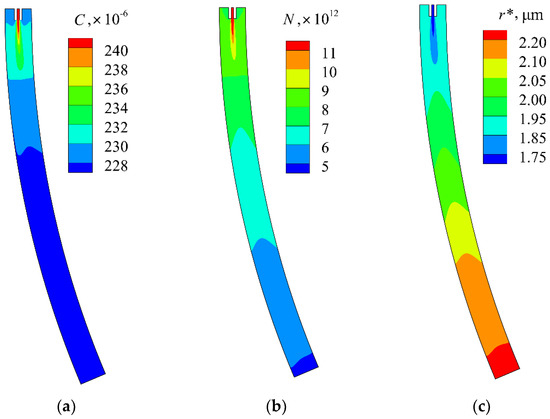
Figure 10.
Inclusion distribution at vertical longitudinal-section in curved bloom continuous caster with M-EMS: (a) volume concentration; (b) number density; (c) characteristic radius.
Figure 9 also shows that the inclusion volume concentration and the inclusion number density near the inner arc are less than that near the outer arc in the case of no M-EMS. Such phenomena come from the fact that the recirculation zone near the inner arc is larger than that near the outer arc shown in Figure 6b.
Figure 10 shows that the spatial distributions of the inclusion characteristic radius, the inclusion number density and the inclusion volume concentration are close to the symmetric distribution in the continuous caster in the case of M-EMS because the related flow field is close to the symmetry pattern shown in Figure 7b.
Figure 10 shows that the inclusion spatial distribution in the case of M-EMS has its own features. (1) The spatial distributions of the inclusion characteristic radius, the inclusion number density and the inclusion volume concentration have the inverted U-shape. (2) The inclusion number density and the inclusion volume concentration in the case of M-EMS is less than that in the case of no M-EMS. (3) The inclusion characteristic radius in the case of M-EMS is greater than that in the case of no M-EMS. Several reasons lead to these interesting phenomena. (1) The liquid steel rotates around the center line of the continuous caster because of M-EMS. (2) The density of inclusion is less than that of liquid steel. (3) The strong electromagnetic force strengthens the turbulent flow in the continuous caster, so it is easier for the inclusions to collide and aggregate with each other on the base of turbulent collision. (4) The strong electromagnetic force also results in a greater contribution of Archimedes electromagnetic collision on the inclusions. (5) The greater the collision rate, the bigger the inclusion.
In the steelmaking process, bearing steel continuous casting technology involves in M-EMS and soft-reduction. At the final solidification zone, soft-reduction affects the fluid flow in the liquid pool. However, the effect of soft-reduction is not considered in the current numerical simulation. Fortunately, 27SiMn steel continuous casting technology only involves in M-EMS, so our numerical result is validated by the total oxygen distribution of 27SiMn bloom quantitatively. Figure 11 shows that the peak value of total oxygen mass fraction appears near the center of the 27SiMn bloom produced by M-EMS, and this peak value is close to inner arc. It should be noted that the inverted U-shape distribution of inclusion volume concentration in the case of M-EMS means there are more inclusions near the center of the bloom and less inclusions near the edge of the bloom. The total oxygen mass fraction is the sum of dissolved oxygen in the molten steel and insoluble oxygen in the oxide inclusion, and the dissolved oxygen is saturated in the steel. Thus, the distribution of total oxygen mass fraction is similar to the distribution of the inclusion volume concentration. In this way, we can come to this conclusion: the predicted inclusion distribution in Figure 10 conforms to the industrial experiment quantitatively.
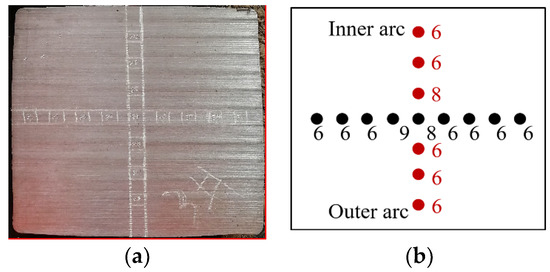
Figure 11.
Total oxygen distribution in the cross-section from industrial result with M-EMS: (a) bloom test point; (b) total oxygen mass fraction, ppm.
4. Conclusions
Based on the Eulerian approach, the effect of Archimedes electromagnetic force on the inclusion can be expressed by Archimedes electromagnetic slipping velocity and Archimedes electromagnetic collision. Thus, the inclusion population/mass conservation model is developed to investigate the collision-coalescence among inclusions in the curved bloom continuous caster with M-EMS. The conclusions are as follows:
- (1)
- Due to the rotating electromagnetic force, the velocity of liquid steel becomes greater and the liquid steel flows in a swirling way at the M-EMS central cross-section.
- (2)
- The turbulent collision is the most important factor to cause inclusions to collide with each other in the bloom continuous caster by M-EMS, Archimedes electromagnetic collision has a minor effect, Stokes collision is the third factor, and Brownian can be ignored.
- (3)
- The inclusion volume concentration and number density decrease and the inclusion characteristic radius increases gradually as the distance from the free surface of the bloom increases.
- (4)
- The spatial distributions of the inclusion characteristic radius, the inclusion number density and the inclusion volume concentration have the inverted U-shape in the case of M-EMS.
- (5)
- The flow field and the inclusion field are close to the symmetric distribution in the curved bloom continuous caster.
Author Contributions
Investigation, W.W. and S.C.; methodology, W.W. and H.L.; writing—original draft preparation, W.W. and S.C.; writing—review and editing, H.Z. and M.J.; validation, H.X.; project administration and funding acquisition, H.L. All authors have read and agreed to the published version of the manuscript.
Funding
This research was funded by National Natural Science Foundation of China and Shanghai Baosteel, as indicated in the acknowledgements.
Acknowledgments
This work was supported by National Natural Science Foundation of China and Shanghai Baosteel (No. U1460108) and National Natural Science Foundation of China (No. 51574074).
Conflicts of Interest
The authors declare no conflict of interest.
Nomenclature
| Magnetic flux density (T) | |
| Conjugate complex number of | |
| C | Inclusion volume concentration |
| Effective diffusion coefficient | |
| Molecular diffusion coefficient (m2/s) | |
| Electric field intensity (V/m) | |
| Time averaged electromagnetic force (N/m3) | |
| Gravitational acceleration (m/s2) | |
| Magnetic field intensity (A/m) | |
| Electric current density (A/m2) | |
| N | Inclusion number density |
| p | Pressure (Pa) |
| r | Inclusion radius (m) |
| Turbulent Schmidt number | |
| Inclusion slipping velocity (m/s) | |
| Coagulation coefficient | |
| Electric conductivity (S/m) | |
| Density (kg/m3) | |
| Effective viscosity coefficient (Pa·s) | |
| Turbulent viscosity (Pa·s) |
References
- Mills, K.C.; Ramirez-Lopez, P.; Lee, P.D.; Santillana, B.; Thomas, B.G.; Morales, R. Looking into continuous casting mould. Ironmak. Steelmak. 2014, 41, 242–249. [Google Scholar] [CrossRef]
- Ilegbusi, O.J.; Szekely, J. Effect of magnetic field on flow, temperature and inclusion removal in shallow tundishes. ISIJ Int. 1989, 29, 1031–1039. [Google Scholar] [CrossRef]
- Zhang, L.F.; Taniguchi, S.; Cai, K.K. Fluid flow and inclusion removal in continuous casting tundish. Metall. Mater. Trans. B 2000, 31, 253–266. [Google Scholar] [CrossRef]
- Li, B.K.; Tsukihashi, F. Numerical estimation of the effect of the magnetic field application on the motion of inclusion in continuous casting of steel. ISIJ Int. 2003, 43, 923–931. [Google Scholar] [CrossRef]
- Zhang, L.F.; Aoki, J.; Thomas, B.G. Inclusion removal by bubble flotation in a continuous casting mold. Metall. Mater. Trans. B 2006, 37, 361–379. [Google Scholar] [CrossRef]
- Tarapore, E.D.; Evans, J.W. Fluid velocities in induction melting furnaces: Part I. Theory and laboratory experiments. Metall. Mater. Trans. B 1976, 7, 343–351. [Google Scholar] [CrossRef]
- Li, J.C.; Wang, B.F.; Ma, Y.L.; Cui, J.Z. Effect of complex electromagnetic stirring on inner quality of high carbon steel bloom. Mater. Sci. Eng. A 2006, 425, 201–204. [Google Scholar] [CrossRef]
- Yu, H.Q.; Zhu, M.Y. Three-Dimensional magnetohydrodynamic calculation for coupling multiphase flow in round billet continuous casting mold with electromagnetic stirring. IEEE Trans. Magn. 2010, 46, 82–86. [Google Scholar]
- Thomas, B.G.; Zhang, L.F. Mathematical modeling of fluid flow in continuous casting. ISIJ Int. 2001, 41, 1181–1193. [Google Scholar] [CrossRef]
- Miki, Y.; Thomas, B.G. Modeling of inclusion removal in a tundish. Metall. Mater. Trans. B 1999, 30, 639–654. [Google Scholar] [CrossRef]
- Lei, H.; Zhao, Y.; Geng, D.Q. Mathematical model for cluster-inclusion’s collision-growth in inclusion cloud at continuous casting mold. ISIJ Int. 2014, 54, 1629–1637. [Google Scholar] [CrossRef][Green Version]
- Lei, H.; Wang, L.Z.; Wu, Z.N.; Fan, J.F. Collision and coalescence of alumina particles in the vertical bending continuous caster. ISIJ Int. 2002, 42, 717–725. [Google Scholar] [CrossRef]
- Tozawa, H.; Kato, Y.; Sorimachi, K.; Nakanishi, T. Agglomeration and flotation of alumina clusters in molten steel. ISIJ Int. 1999, 39, 426–434. [Google Scholar] [CrossRef]
- Lopez-Ramirez, S.; Barreto, J.D.J.; Palafox-Ramos, J.; Morales, R.D.; Zacharias, D. Modeling study of the influence of turbulence inhibitors on the molten steel flow, tracer dispersion, and inclusion trajectories in tundishes. Metall. Mater. Trans. B 2001, 32, 615–627. [Google Scholar] [CrossRef]
- Javurek, M.; Gittler, P.; Rossler, R.; Kaufmann, B.; Presslinger, H. Simulation of nonmetallic inclusions in a continuous casting strand. Steel Res. Int. 2005, 76, 64–70. [Google Scholar] [CrossRef]
- Lei, H.; Xu, G.J.; He, J.C. Magnetic field, flow field and inclusion collision growth in a continuous caster with EMBR. Chem. Eng. Technol. 2007, 30, 1650–1658. [Google Scholar] [CrossRef]
- Lei, H.; Yang, B.; Bi, Q.; Xiao, Y.Y.; Chen, S.F.; Ding, C.Y. Numerical simulation of collision-coalescence and removal of inclusion in tundish with channel type induction heating. ISIJ Int. 2019, 59, 1811–1819. [Google Scholar] [CrossRef]
- Trindade, L.B.; Nadalon, J.E.A.; Vilela, A.C.F.; Vilhena, M.T.M.B.; Soares, R.B. Numerical modeling of inclusion removal in electromagnetic stirred steel billets. Steel Res. Int. 2007, 78, 708–713. [Google Scholar] [CrossRef]
- Wang, S.Q.; Toledo, G.A.D.; Valimaa, K.; Louhenkilpi, S. Magnetohydrodynamic phenomena, fluid control and computational modeling in the continuous casting of billet and bloom. ISIJ Int. 2014, 54, 2273–2282. [Google Scholar] [CrossRef]
- Yang, B.; Lei, H.; Bi, Q.; Xiao, Y.Y.; Zhao, Y. Numerical simulation of collision-coalescence and removal of inclusions in a tundish. JOM 2018, 70, 2950–2957. [Google Scholar] [CrossRef]
- Zhang, J.; Lee, H.G. Numerical modeling of nucleation and growth of inclusions in molten steel based on mean processing parameters. ISIJ Int. 2004, 44, 1629–1638. [Google Scholar] [CrossRef]
- Saffman, P.G.; Turner, J.S. On the collision of drops in turbulent clouds. J. Fluid Mech. 1956, 1, 16–30. [Google Scholar] [CrossRef]
- Zhao, L.G.; Liu, K. Study on inclusion behavior in tundish during continuous casting by mathematical model. J. Iron Steel Res. 2002, 14, 19–24. [Google Scholar]
- Yang, B.; Lei, H.; Bi, Q.; Jiang, J.M.; Zhang, H.W.; Zhao, Y.; Zhou, J.A. Fluid flow and heat transfer in a tundish with channel type induction heating. Steel Res. Int. 2018, 89, 1800173. [Google Scholar] [CrossRef]
Publisher’s Note: MDPI stays neutral with regard to jurisdictional claims in published maps and institutional affiliations. |
© 2020 by the authors. Licensee MDPI, Basel, Switzerland. This article is an open access article distributed under the terms and conditions of the Creative Commons Attribution (CC BY) license (http://creativecommons.org/licenses/by/4.0/).